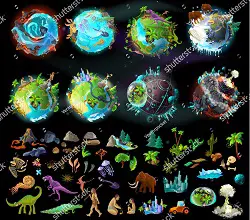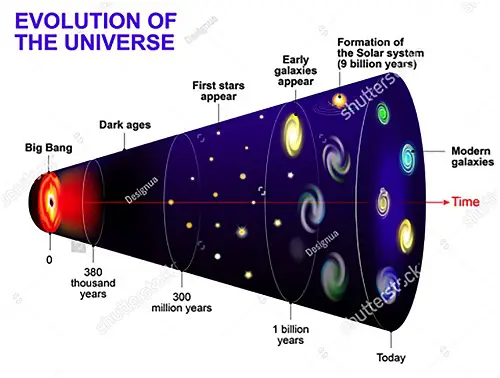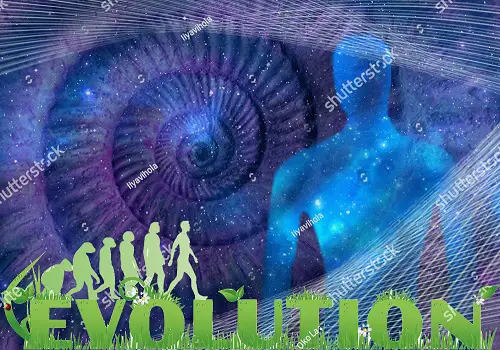TRANSLATE THIS ARTICLE
Integral World: Exploring Theories of Everything
An independent forum for a critical discussion of the integral philosophy of Ken Wilber
SEE MORE ESSAYS WRITTEN BY BRAD REYNOLDS
Integral Evolution:
A Neo-Perennial Philosophy
Brad Reynolds

O
ne of the great clarifications and contributions of today's Integral Philosophy is the inclusion of evolution, or progressive development, even as the Kosmos is manifesting as a ever-present expression of the Divine Transcendental Condition. In this case, it is not necessary to postulate a Golden Age in the ancient past, or a final Judgment Day in the upcoming future, or even a “Perennial” Philosophy that always remains exactly the same. Only God, or the Divine Ground of Being, is the real truth that is timeless and whole, transcendent and free. Therefore, the idea of a universal “Perennial Philosophy” as being modified or upgraded to our current historical standards falls totally within the province of Integral Theory, according to Ken Wilber.
With the advent of a detailed evolutionary understanding, Wilber has dubbed this more highly evolved expression of the Perennial Philosophy as the “Neo-Perennial Philosophy.”[1] This version has been accomplished primarily by inserting the primacy of evolution as being the developmental engine of a spiritual universe—“Spirit-in-action” (in Wilber's words). This is what is seen when one observes the Kosmos as a multi-leveled spectrum emerging and unfolding through billions of years of creation. This is the “Big History” (in current academic terms) of the “Universe Story” (in Brian Swimme's terms).[2] Evolution is today's version of the “Creation Story,” yet told with the facts of scientific observation, yet without its reductionism. Once evolution (both prior to and after Darwin) began to work its way into the modern mind (by the mid-19th-century), philosophers and scientists, such as Hegel, Schelling, Teilhard de Chardin, Blavatsky, Vivekananda, Aurobindo, Bergson, Gebser, Wilber, and others, began working with its thesis and how it might change (or upgrade) our view of reality.

Of course, from a strict “scientific” materialistic view, one focused mostly on biological evolution (as natural selection), the addition of a spiritual purpose or telos (“ultimate aim”) seems like hocus-pocus by adding unnecessary ingredients (or theories). Yet, other integral visionaries see no inherent contradiction by including science's measurements in a spiritual vision of reality, they simply reject its philosophical conclusion of materialism. With such an “Integral Vision,” as Wilber puts it, it is critically important to “see” (or understand) not only with the Eye of Science (the Eye of Flesh and Eye of Mind), as moderns do, but also with the Eye of Spirit, as the mystics do.[3] This integration of evolutionary development, from atoms to apes, from dust to divinity, is seen to recapitulate itself in certain ways within the psychological development of the human psyche.
As Wilber wisely noted in The Atman Project (1980): “The form of development, the form of transformation—that is constant, as far as I can tell, from the womb to God…. Development is evolution; evolution is transcendence… and transcendence has as its final goal Atman, or ultimate Unity Consciousness in only God.”[4] This new view of evolution is supplemented with the advancements of science, not canceled out by its materialistic reductionism. Based on the precise measurements of Nature, down to the very atom (and subatomic particle), a complete understanding of cosmic evolution naturally escaped our ancient Seers (although they did understand its general possibility). They did not have microscopes and telescopes, nor an understanding of DNA, and so forth, but they had consciousness and the capacity to realize the Ultimate Truth (Sophia), not merely relative truths.
Integral thinkers, therefore, point out the evolutionary story was not a notion fully understood by our ancient masters in the traditional Perennial Philosophy, at least in detail, although they did recognize the developmental process in general terms. Integral pioneer Michael Murphy, for example, agrees as he soberly reminds us in his monumental book on human transformative capacities, The Future of the Body (1992):
When the Upanishads, Buddhist sutras, and Tao Te Ching were composed—indeed, when the first teachings of all the great contemplative schools were formulated—their authors did not have our modern knowledge of cosmic and biological development. Though the sacred traditions nurtured understanding of numerous extraordinary capacities, they could not comprehend the history of advances in structural complexity, behavioral repertoire, and awareness among living species.[5]
One of the exquisite beauties offered by the Integral Vision (grounded in sophia perennis or seeing with the Eye of Spirit) is that it presents an understanding of evolution that integrates both the ancient intuition of a sacred creation along with the secular scientific reconstructions of how the universe came into existence and continues to exist. Such an understanding generates its own version of “The Story” and a “Theory of Everything,” which includes the physiosphere (matter), biosphere (life), noosphere (mind), and theosphere (spirit), or all the realms of existence (in Wilber's terms).[6] Not only the gross-physical, but also the subtle-mental and soulful dimensions of the Kosmos are included.
Instead of telling the Creation Story in mythic time, now it's the Universe Story told in measurable time. Instead of just describing the exterior evolution of galaxies, stars, planets, and biological life forms, the integral version of our Evolutionary Story now includes the interior dimensions as being an unfolding evolving spectrum of consciousness (including the reality of Divine Enlightenment). Integral Theory, therefore, throws out the unnecessary mythical illusions and dogmas of the past, the fancy stories and pictorial metaphors of gods and goddesses (yet still honors their archetypal force), while retaining the mystical or spiritual quality contained in the heart of ancient wisdom. In this case, this advanced post-postmodern view wisely dispenses with the “Creator God,” not as an overarching Parent-Deity controlling everything, but rather as the transcendent-immanent Spirit-Energy—or Eros (in Wilber's words)—creating evolution itself. Evolution is Spirit-in-action, Eros-in-motion, when seen integrally.

At the same time, an integral view of evolution corrects the reductionistic scientific tale of creation by eliminating science's stark materialism while accepting its precision of measurement and detailed accuracy. In this way, by using an Integral Vision—based upon a transpersonal understanding of evolution—the global community finally has a spiritually-infused, divinely-oriented Creation Story based upon observable, measurable, and empirical evidence.[7] It's not simply a “creationist” tale (for there is no Creator God doing the work), nor it is a purely scientific one allowing only chance and necessity to be its sole creative force. Indeed, as mentioned, it is a developmental unfolding (literally, an “evolution”) of “Spirit-in-action” or the natural manifestation of the formless Divine Ground and Source-Condition into the multiplicity of forms. Spirit (or the Divine Reality) sets the laws of Nature into motion, so to speak, evolving into ever-greater complexities (perhaps leading to a final “Goal” of Enlightened understanding).
Nonetheless, in essence (and overall), the Enlightened Wisdom of the Perennial Philosophy (Sophia perennis) does not evolve; it is timeless (or eternal), not subject to the conditions of history and the human ego (or scientific measurements). Nonetheless, as Wilber has noted, the articulation and teachings of the Yogis, Saints, and Sages themselves have evolved in greater detail during historical time. Even “advanced-tip” individuals continue to evolve, according to Wilber, during the evolution of collective consciousness—from the archaic to magic to mythic to rational to pluralistic to integral to mystical worldviews (in Gebser-Wilber's terms).[8] Nevertheless, the importance of human development (both as “Growing Up” and “Waking Up”), i.e., the evolution of consciousness itself, has been adequately mapped by many advanced-tip pioneers of our past collective eras. Thus, such recent evolutionary philosophers, from Hegel to Aurobindo, Gebser to Radhakrishnan, from Schelling to Teilhard de Chardin, from Aldous Huxley to Ken Wilber have proposed that human history unfolds and human consciousness evolves to (and in) Real God, or its own inherent Divine Condition, consequently, so does its philosophical ideas and religious thought.
Integral Post-Metaphysics
W
ilber's Neo-Perennial Philosophy attempts to upgrade the insights of “ancient” wisdom, which by themselves are the old ideas of traditions and customs, by adding the perennial “Ancient Wisdom” or timeless universals of the Perennial Philosophy. Yet, now, this Sophia-Wisdom is to be integrated with the evidence of emergent evolution.[9] Wilber goes on to make this idea the backbone of his current integral “post-metaphysical” position, as he explains:
Here is my point: we might say that the idea of evolution as return-to-Spirit is part of the Perennial Philosophy, but the idea itself, in any adequate form, is not more than a few hundred years old [probably beginning, perhaps, with Hegel]. It might be “ancient” as timeless, but it is certainly not “ancient” as “old.”… The point is that the evolution of the forms of Truth clearly shows a succession of increasingly adequate and more comprehensive structures for truth's expression and representation…. The past had the Great Religions. The future will have the Greater Religion.[10]
A bit idealistic (or an Omega-mind view), perhaps, but still, Wilber should know that a “Greater Religion” will only be possible through the presence of authentic Adept-Realizers and genuine Gurus. Each further development of spiritual teachings across the millennia have all arisen from advanced-tip Adept-Realizers, not scholar-pandits. They are the ones who express the timeless wisdom (of Sophia perennis) by communicating the deeper articulations of its truths in a more sophisticated language over the centuries. By doing so, they often improve and refine the actual techniques of spiritual practice. Wilber, for one, has been adamant in supporting this notion, as he explained in The Eye of Spirit (1997): “What I think is an absolutely tight case: both the quality of humanity's spiritual understanding, and the form of its presentation, is deepening and becoming more adequate in modern times, not less.”[11] Evolution, in other words, occurs in the consciousness of human thought (and awareness) as much as it does in the physical cosmos, yet it is eternally transcended in its Divine Ground (or Spirit-Light).
In this sense, a truly integral and Neo-Perennial Philosophy is fighting this battle on several fronts: one, against premodern traditionalism that refuses to fully recognize the gains made by modernity. By not understanding (or believing in) evolution as a developmental principle, the premodern mind misses the “good news” and “bad news” inherent in the dialectic of progress where each new era has its own “dignities” and “disasters” (in Wilber's words).[12] Two, integral philosophy must stand up against a reductionistic modernity that is slow to recognize a full spectrum of consciousness or an evolutionary hierarchy by eliminating the higher transpersonal Stages of Life (or mysticism in general, thus committing the pre/trans fallacy). Third, an integral theory based on evolution as Spirit-in-action must counter the postmodern critiques against Hegelian type of metatheories and the notion that all “universals” and “truths” are culturally-conditioned and constructed. The integral approach, however, is unique in that it integrates all the previous stages (and eras) by honoring the “dignities” (or achievements) of each, yet eliminating their “disasters” (or failed adaptations). Importantly, the emerging Integral Vision sees no strong antagonism between science and spirit; thus, for example, evolution is realized to be a dynamic and creative process of Spirit-in-action (not one merely of blind chance).
In answer to some of these objections by the premodern, modern, and postmodern mind, Integral Philosophy appeals to the Great Wisdom Traditions of humankind (and its Perennial Philosophy) in order to demonstrate that true wisdom is cross-cultural, and that we are united as a human race prior to cultural differentiation. That is, the integral view differentiates the deep structures (or cross-cultural universals) from the surface features of cultural variation. Furthermore, Integral Philosophy is willing to acknowledge that some aspects of its transpersonal view of history are influenced by cultural constructions. Therefore, it offers a carefully modeled reconstruction from a certain time and place in history (and thus is subject to revision). It doesn't claim to be the “final truth,” in other words, for it too is evolving. The difference is, as integral ecologist Michael Zimmerman points out, “[this integral reconstruction of history is] a useful one that encourages the development of the kind of consciousness that would no longer need such a construction.”[13] Thus, a genuine Integral Philosophy is not Euro-centric, Afro-centric, egocentric or ethnocentric—but actually a “world philosophy,”[14] one that is world-centric and beyond. Since it is ultimately grounded in a nondual (enlightened) awareness, then it is ultimately “Kosmocentric” because it embraces all realms, all beings and possibilities (gross, subtle, causal), as an expression of the holy “body” or immanent “relative realm” of the transcendent Absolute Divine or God Itself.
In this manner, an integral evolutionary philosophy diffuses the classic debate between traditional “creationists” (and proponents of so-called “intelligent design”) and modern scientific “evolutionists,” since both sides are intellectually evaporated.
In this manner, an integral evolutionary philosophy diffuses the classic debate between traditional “creationists” (and proponents of so-called “intelligent design”) and modern scientific “evolutionists,” since both sides are intellectually evaporated when offering a truly holistic and mystical, yet critically non-mythical, explanation for the creation of the Kosmos. Since everything is grounded in the radiant and mysterious play of Divine Spirit-in-action, this view becomes a truly integral “Theory of Everything.” Such a “marriage of sense and soul,”[15] as one Wilber book titled it, is in truth a unique and emerging worldview arising within the collective level of consciousness development, especially in order to generate a peaceful global culture. Evolution in all domains, realms, or levels is fully taken into account by integral metatheories, yet while never making the claim to understand all there is to know about it. This way, both the ancient and modern views, the immanent and transcendent, are each empowered and harmoniously united… yet something more is added.

This alone makes Integral Philosophy an important achievement in the entire intellectual history of the human race, yet it still needs to be grounded in the enlightened wisdom or Sophia of our Adept-Realizers (a position that Wilber, unfortunately, has recently been slow to acknowledge). Nonetheless, such an integral perspective is still based upon and grounded in the Perennial Philosophy, or “Neo-Perennial Philosophy”—the Great Global Wisdom Tradition—an understanding that includes Divine Enlightenment and God-Realization within its developmental models. Yet, as a corrective to the Western-Omega bias toward the evolution of forms (in “this world”), including the relative reality of the Earth realm, it is still crucially important to listen to (and integrate) an Enlightened perspective in uniting the two bi-polar divisions of the human psyche optimized in the notions of “the East” and “the West.” In short, we need to celebrate the “sacred marriage” (hieros gamos) of mysticism and science, the Enlightenments of both East and West, shining as One Reality (or Prior Unity) guiding our way forward in time and with wisdom.
NOTES
[1] See: Ken Wilber, “The Neo-Perennial Philosophy” in The American Theosophist, Special Fall Issue, 1983, pp. 349-355, now embedded in Chapter 2: “In a Modern Light: Integral Anthropology and the Evolution of Consciousness,” in The Eye of Spirit (1997) by Ken Wilber.
[2] See: Origin Story: A Big History of Everything (2018) by David Christian; Maps of Time: An Introduction to Big History (2004) by David Christian; The Universe Story (1994) by Brian Swimme.
[3] Ken Wilber, Eye to Eye (1982, 2001); The Eye of Spirit (1997, 2000).
[4] Ken Wilber, The Atman Project (198), p. 79, ix.
[5] Michael Murphy, The Future of the Body (Los Angeles: Tarcher, 1992), p. 172.
[6] See: Ken Wilber, A Theory of Everything (1999, 2001).
[7] See: Our Kosmos Story: Marvelous Mystery Beyond Word or Measure (forthcoming) by Brad Reynolds.
[8] See: Ken Wilber, Up From Eden (1980); Sex, Ecology, Spirituality (1995, 2000); The Eye of Spirit (1997, 2000); The Religion of Tomorrow (2017).
[9] See: Ken Wilber, “The Neo-Perennial Philosophy” in The American Theosophist, Special edition, Fall, 1983, pp. 349-355; Quest, Autumn 1992, pp. 16-21; also Chapter 2 “In A Modern Light” in The Eye of Spirit (1997), pp. 58ff.
[10] Ken Wilber, The Eye of Spirit (1997), p. 65; The Religion of Tomorrow (2017).
[11] Ken Wilber, The Eye of Spirit (1997), p. 62.
[12] See: Ken Wilber, The Eye of Spirit (1997), p. 58; Sex, Ecology, Spirituality (1995, 2001).
[13] Michael Zimmerman, Contesting Earth's Future (1997), pp. 225-226.
[14] See, for example: Ken Wilber, A Theory of Everything (2000), p. 38:
“I sought a world philosophy—or an integral philosophy—that would believably weave together the many pluralistic contexts of science, morals, aesthetics, Eastern as well as Western philosophy, and the world's great wisdom traditions. Not on the level of details—that is finitely impossible; but on the level of orienting generalizations: a way to suggest that the world really is one, undivided, whole, and related to itself in every way: a holistic philosophy for a holistic Kosmos, a plausible Theory of Everything.”
[15] Wilber's 1998 book (originally written in 1997), was originally titled “The Integration of Science and Religion,” but was renamed by his Random House publishers to The Marriage of Sense and Soul, after the Oscar Wilde quote opening the book: “There is nothing that will cure the senses but the soul, and nothing that will cure the soul but the senses.”
|
 Brad Reynolds did graduate work at the California Institute of Integral Studies (CIIS) before leaving to study under Ken Wilber for a decade, and published two books reviewing Wilber's work: Embracing Reality: The Integral Vision of Ken Wilber (Tarcher, 2004), Where's Wilber At?: Ken Wilber's Integral Vision in the New Millennium (Paragon House, 2006) and God's Great Tradition of Global Wisdom: Guru Yoga-Satsang in the Integral Age (Bright Alliance, 2021). Visit: http://integralartandstudies.com
Brad Reynolds did graduate work at the California Institute of Integral Studies (CIIS) before leaving to study under Ken Wilber for a decade, and published two books reviewing Wilber's work: Embracing Reality: The Integral Vision of Ken Wilber (Tarcher, 2004), Where's Wilber At?: Ken Wilber's Integral Vision in the New Millennium (Paragon House, 2006) and God's Great Tradition of Global Wisdom: Guru Yoga-Satsang in the Integral Age (Bright Alliance, 2021). Visit: http://integralartandstudies.com



